The common saying “first impressions are everything” holds true when potential customers are evaluating your business. In fact, it only takes people an average of 7 seconds to form an impression of your brand. Your brand messaging can make or break that first impression.

Whether you’re starting out with totally new brand messaging, or looking to refresh your current brand messaging, compelling brand messaging can help you convey the most important aspects of your business to your audience in a meaningful way.
Today, I’m going to give you the ultimate breakdown of everything you need to know about brand messaging—including how to create a brand messaging framework that makes it easy to craft the perfect communications for your business. Plus, you’ll get to walk away with a free brand messaging template you can use to get started!
Table of contents
- What is brand messaging?
- Why is brand messaging important?
- How to create a brand messaging framework
- When and where to use your brand messaging
- Brand messaging examples
- Brand messaging template
What is brand messaging?
Brand messaging is how you communicate your business’s unique value, mission, and personality. Nearly all external and internal communication surrounding your business falls under your brand messaging.
A brand messaging framework is a set of guidelines that helps you identify your brand voice and keep your messaging consistent when creating marketing assets such as:
- Website and landing page copy
- Email content
- Social media posts and ads
- Search ad copy and creative
- A mission statement or company core values
- Video scripts and creative for OTT advertising
- SEO and blog content
- Local listing content
- Slogans and taglines
- Live chat scripts
- And more!
In fact, here are some of the top marketing channels businesses use to deploy their brand messaging:
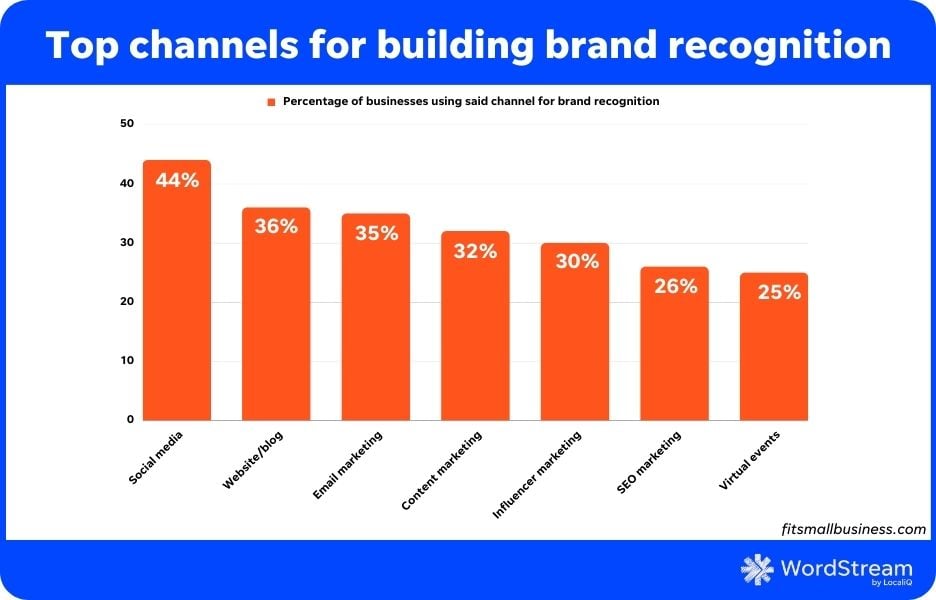
💡 Put your brand messaging to work with this free guide on the 30 best ways to promote your business!
Why is brand messaging important?
Brand messaging plays a role in just about every aspect of your business! So, it’s a necessary element of any marketing plan. However, a strong brand messaging framework can also positively impact your business’s bottom line. Consider these statistics:
- 81% of consumers need to trust a brand before they consider buying from it.
- 88% of consumers say authenticity is an important deciding factor in which brands they like and support.
- 77% of people buy from brands that share the same values as them.
- Brand consistency can increase small business revenue by 10-20%.
- 15% of companies don’t have brand messaging guidelines.
- Nearly half of all businesses publish off-brand content a few times a year—if not more.
- 13% of businesses don’t enforce their brand messaging guidelines.
This data proves that brand messaging can be a powerful tool when trying to convince your potential customers to do business with you. On top of that, having a strong brand messaging framework can put you ahead of many other competitors that are lacking in the brand department (and improve your brand’s perception).

How to create a brand messaging framework
Before you go live with iron-clad brand messaging, you’ll need to set up a brand messaging framework. Here are the seven steps to create a brand messaging framework that works best for your business.
1. Start with your brand’s mission statement
The tricky part of creating a brand messaging framework is you may find yourself in a “what came first? The chicken or the egg?” situation. Your brand messaging should be crafted around your business’s mission statement…but you need a strong brand messaging framework to create the best mission statement possible.
That said, your mission statement can help structure your brand messaging framework around your business’s core objectives. So, using this post on how to write a mission statement, try circling in on your business’s mission statement as the first step to a good brand messaging framework. Then, once your framework is set and you start implementing your brand messaging, you can always go back to tweak and perfect your mission statement accordingly.
2. Set goals
Your goals are going to indicate what you want your brand messaging to ultimately achieve. Be sure to take inventory of your business’s short and long-term goals in marketing so you can assess what your brand messaging framework should be working towards.
For example, if one of your goals is to get more leads, you likely will be looking to drive more traffic to your website so that potential customers can fill out a contact form or call your business. With that in mind, you could create a brand message that entices customers with an “all online” process.
For reference, here are some of the top goals that drive most business’s brand messaging:

3. Research your target market
Brand messaging isn’t only about what you say, but also how you say it, and more importantly, to whom you say it. Knowing your target audience is key to crafting the perfect brand messaging that resonates with them, relates to them, and ultimately convinces them to do business with you. This might feel silly at first but take a moment to picture your ideal customer. Think about:
- What they might look like
- Their lifestyle
- Their job
- Their income
- The family and friends they might have
- The devices or platforms they might use and when they’d be on them
- Where they live
- What they do for fun
- The types of content or brands they enjoy
Considering target market traits like these can help you pinpoint how to correctly craft and deliver your brand messaging.
For example, if your home services business is targeting middle-aged homeowners, you might focus on a family-friendly brand message since your potential customers likely prioritize family time. Next, you could decide to include OTT advertising (like Hulu Ads) as a key marketing channel in your brand messaging framework, since your audience is likely streaming home renovation shows.
4. Analyze your competitors’ brand messaging
I’m not suggesting this brand messaging framework step so that you can duplicate or tease your competitors’ messaging in your own content. In fact, two-thirds of consumers think it’s annoying when brands make fun of their competitors. So, you don’t want to do competitor analysis just to create a defensive brand messaging framework.
Instead, use the brand messaging of your competitors to get a feel for what you may or may not prefer in your own content. Seeing how your competitors present themselves can help you understand what the standards might be in your industry and how you can set yourself apart.
Try these competitive analysis templates to guide your research.
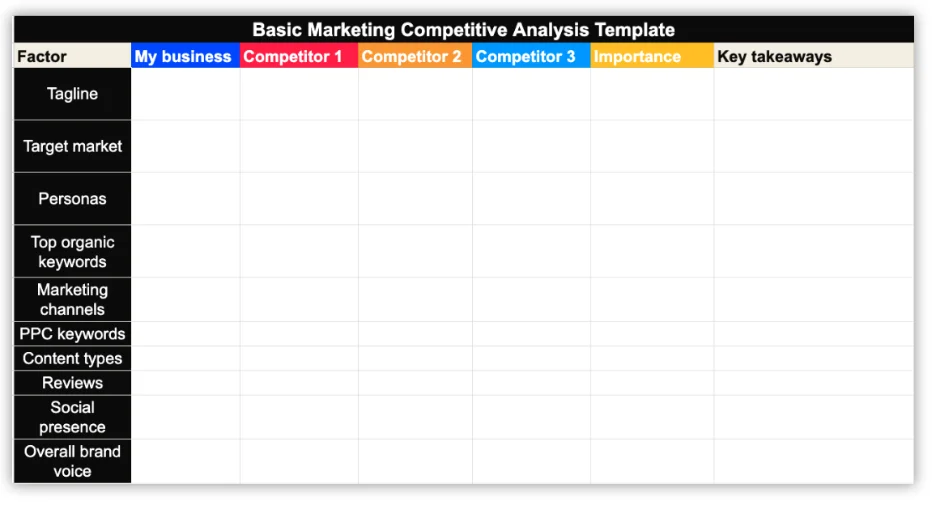
5. Set your unique brand voice and tone guidelines
As I mentioned earlier, your brand messaging framework is, essentially, a set of guidelines to help shape your marketing communications. With that is going to come some rule setting. You’ll want a set of standards in place to make it easy for your team to follow your brand guidelines.
This includes any notes or examples of your ideal tone and voice depending on what works best with your audience. You may also want to refer to your brand kit for any grammar, font, or creative preferences that could impact how your brand messaging comes across.
6. Identify core terms, keywords, and CTAs
To easily maintain your brand messaging throughout your marketing journey, try sticking to a short list of buzzwords, keywords, or calls to action that your team can keep coming back to. This helps to ensure your brand messaging stays consistent over time since you’ll continuously use the same core terms that reinforce your business’s purpose. Plus, ideally, your brand messaging is also aligned with your SEO strategy, so that your brand messaging across your online assets can help you rank for top keywords.
🔍 Use our Free Keyword Tool to find out which terms you need to include in your brand messaging!
7. Try following the 3 C’s
You may have already heard of the 3 c’s for brand messaging, but let’s take a deeper dive into what these “c’s” actually mean when constructing your brand messaging framework. The 3 cs for brand messaging stand for consistency, clarity, and character. Here’s a breakdown of each:
- Consistency: Your brand messaging should align with your business’s style and reinforce your unique personality. You never want your audience to see your brand messaging out of context and not recognize what business it’s associated with. Be sure you keep to the same types of brand messages over time, so your audience becomes familiar with your business.
- Clarity: Your brand messaging should be crystal clear and to the point. More importantly, your brand messaging should always be concise. With smaller screens and shorter attention spans, you need to get your point across quickly and efficiently.
- Character: Don’t be afraid to get creative with your brand messaging to help your business stand out!
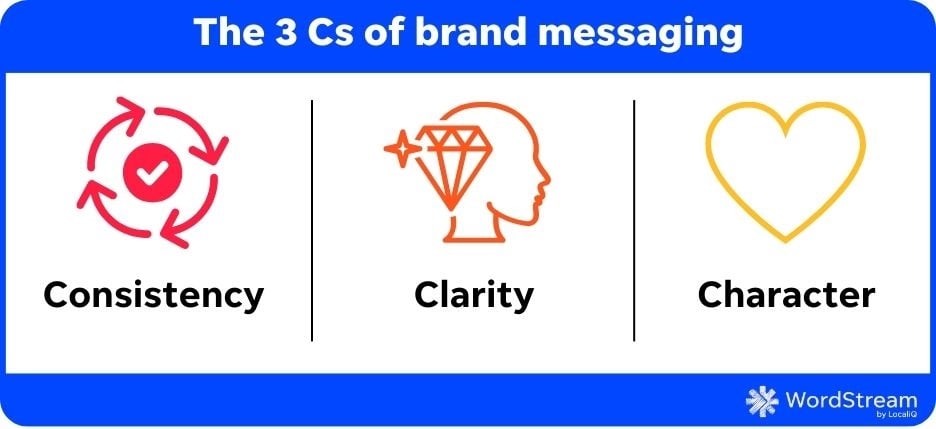
When and how to use your brand messaging framework
Once you’ve followed the steps above to complete your own brand messaging framework, it’s time to put it into practice! Here’s how:
When not to use your brand messaging framework
Since your brand messaging will inevitably be involved in most of your marketing efforts, it’s easier to name off when you shouldn’t take brand messaging into consideration. Let’s talk through a couple of examples. You don’t necessarily need to refer to your brand messaging framework when you’re…
- Working with an influencer. Okay, I know influencer marketing is a brand-heavy initiative. However, keep in mind that most influencers already have their own content style. Plus, today’s audiences can see right through inauthentic or forced content. So, while you want any influencer-sponsored content to align with your brand, try not to push the influencer to abide by your brand messaging framework. Instead, find influencers with a content style that already fits well within your industry, and trust them to create a post that will speak best to their audience (which is ultimately who you’re trying to reach in this case).
- Partnering with another business. Similar to my point about working with influencers above, you may need to find a compromise when combining marketing initiatives with another small business. Look for harmony between both of your brands so that audiences are inspired to work with both of you, rather than confused about who’s who.
- Writing sensitive ad copy. Whether you’re in a highly regulated or restricted industry (such as healthcare or finance), or if you’re simply stating what your offer details, you may need to be more conservative with the language you use to avoid any legal issues. Catchy brand messaging is great, inaccurate brand messaging that overpromises or oversees any audience sensitivities is not.
Those are just a few instances where your brand messaging framework may not always need to come into play. Otherwise, you’ll likely want to refer to your brand messaging framework whenever you’re planning marketing campaigns and creating marketing assets.

This influencer put her own twist on the typical brand messaging from garbage bag company, Glad.
How to use your brand messaging framework
As I just mentioned above, you’ll probably look to your brand messaging framework more often than not when promoting your business. Try to use your framework as an outline any time you’re looking to create or edit marketing copy and creative.
For example, let’s say you decide to incorporate AI in your marketing and use a tool like Chat GPT for a first draft or outline. From there, use your brand messaging framework to edit and ensure that the final copy is on point.
5 brand messaging examples to learn from
Aside from looking at your competitors, checking out brand messaging examples from other growing businesses is another smart way to get brand messaging ideas. Here are a few brand messaging examples across platforms:
1. Brand messaging on social media: example from Liquid Death
Water company Liquid Death is known to go after a younger audience with its edgy packaging, product placements, and overall brand feel. This is reinforced in its brand messaging on social media with the goofy TikTok they posted using a fun mascot. The messaging focused on slang that resonated with the target market using the word “mid” to describe other types of drinks.

2. Brand messaging in search ads: example from Under Armour
This brand messaging example from Under Armour conveys a unique personality through the text in the search ad. Addressing users directly using “you” makes the brand seem more friendly, familiar, and personable—which is key for a brand that’s nearly in every neighborhood shopping center selling intimate items like sports bras, under layers, and more.
Additionally, mentioning “technology,” “tech,” and “performance” throughout the ad capitalizes on the brand’s core goal of providing cutting-edge workout gear to shoppers.
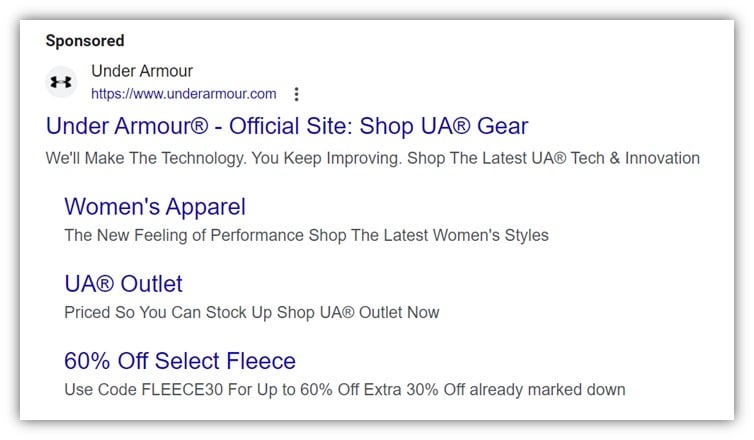
3. Brand messaging in display advertising: example from Workday
Workday’s display ad in this brand messaging example is short and simple. However, it uses power words like “collaboration,” “integration,” and “insight” in its brand messaging to make an impact.

4. Brand messaging on a website: example from Zapier
The brand messaging on the Zapier website is clear and consistent on every one of its pages. Like the other brand messaging examples above, it reinforces a few core terms. These are likely also Zapier’s target keywords—making it both a brand messaging and an SEO win. throughout. That said, this brand messaging example is also a great display of value-driven language. Zapier’s brand messaging focuses on the value it brings to its customers.

5. Brand messaging in live chat: example from HipLink
Believe it or not, your brand messaging can even shine through in your live chat instances. The small B2B software business, HipLink, is a great example of this with its chatbot prompts that use promotional language. This brand messaging example focuses on two main value propositions and uses an overall friendly tone.

Brand messaging template
Hopefully, those brand messaging examples above inspired you and you’re feeling ready to get started with your brand messaging! Kick your journey off using this free brand messaging template:
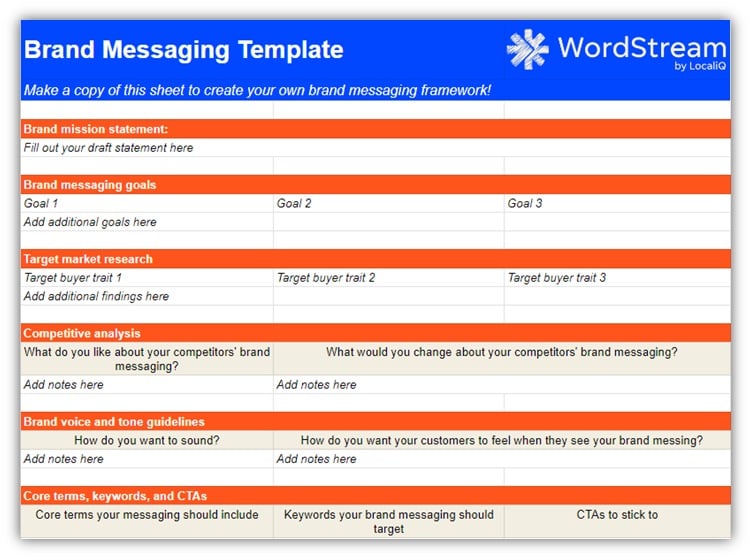
Consider brand messaging your key to unlocking marketing success
When it comes to small business digital marketing, it all starts with brand messaging. Brand messaging can have a lasting impact on how your business is perceived by potential customers. It may take a bit of time or trial and error to get your brand messaging framework just right, but it will be well worth it once you build a powerful brand community with your customers. If you need help putting your brand messaging into play, see how our solutions can help you make the most of your brand messaging across marketing channels!
To recap, here are the steps for creating an effective brand messaging framework:
- Start with your brand’s mission statement
- Set goals
- Research your target market
- Analyze your competitors’ brand messaging
- Set your unique brand voice and tone guidelines
- Identify core terms, keywords, and CTAs
- Try following the 3 C’s







